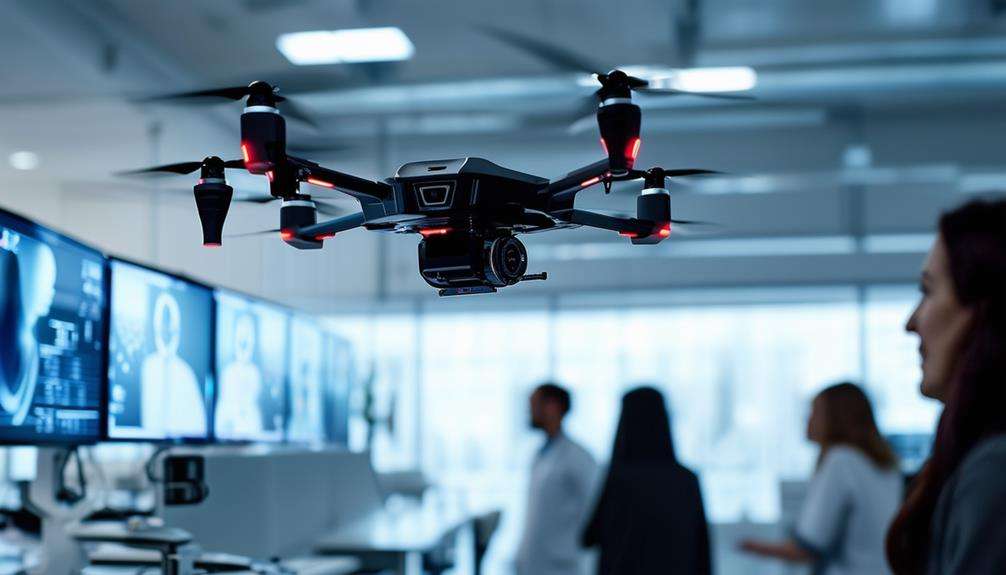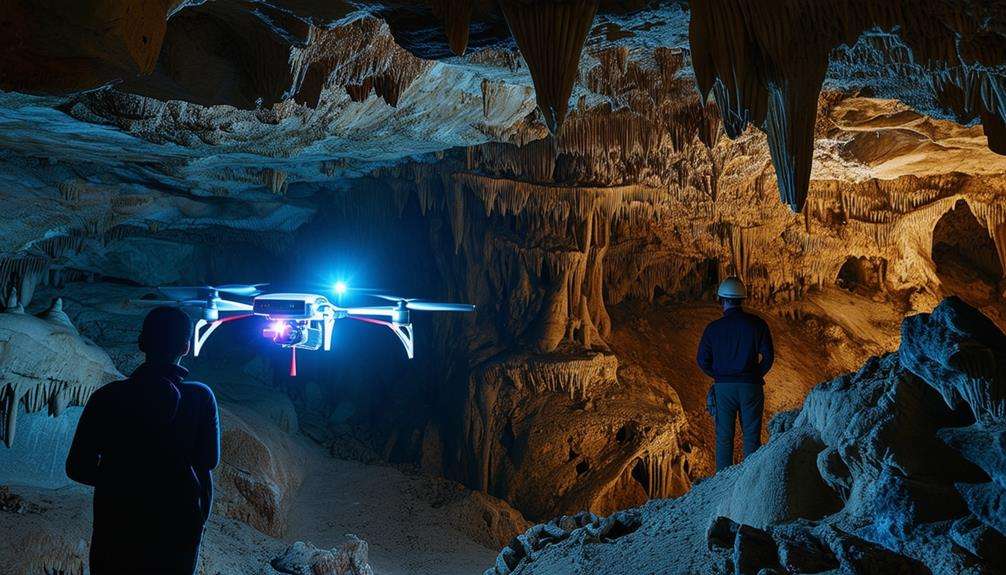Can I Use a Drone Inside a House?
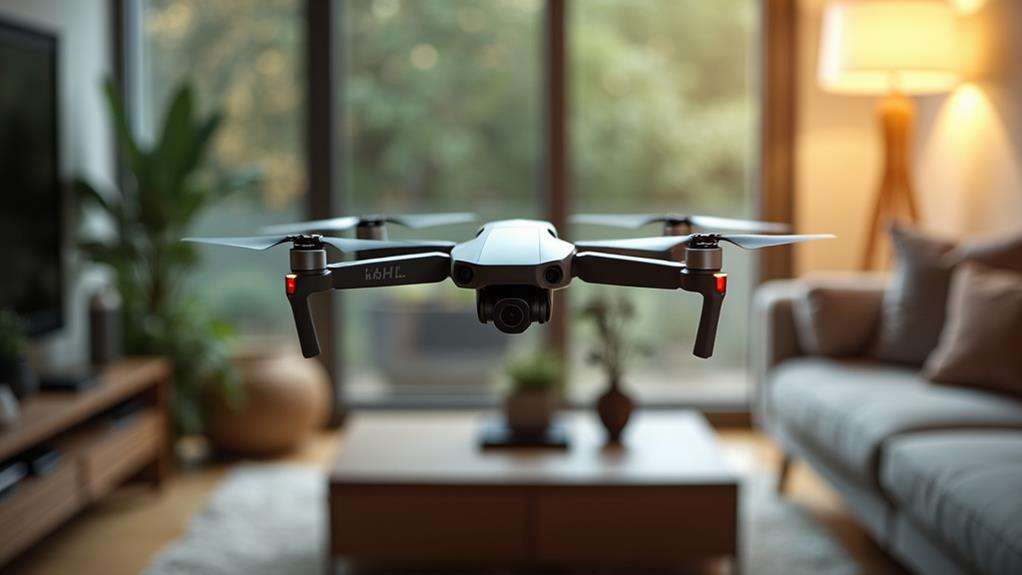
Flying a drone inside your house is possible but requires careful consideration of several factors. Indoor obstacles can interfere with signal strength and GPS, complicating control. Opt for smaller drones designed for indoor use and equip them with propeller guards for added safety. Communicate with others in the room to ensure their awareness and maintain a clear visual line of sight. By taking these precautions, you can make indoor flying both safe and enjoyable.
Signal Range Challenges
Navigating the signal range for drones inside a house presents unique challenges. Indoor obstacles like walls, windows, and furniture can significantly weaken your drone's signal, leading to unexpected signal loss and making indoor flight more unpredictable than outdoor environments. While ensuring your controller antenna is at an optimal height can help, it is not a foolproof solution.
Testing your drone's signal range outdoors before attempting an indoor flight is advisable. Outdoor testing provides a clearer picture of the drone's capabilities without the hindrance of indoor obstructions, helping you gauge potential signal strength loss when flying indoors. Despite this preparation, situational awareness remains crucial. Indoor environments make it harder to see and avoid obstacles, increasing the risk of interference and loss of control.
Additionally, indoor environments can disrupt GPS signals, complicating your flight. Poor satellite reception can affect your drone's stability and control, making precise maneuvers difficult. Understanding these signal range challenges helps you better prepare and mitigate risks when flying your drone inside a house.
Safety and Legal Considerations
Understanding the signal range challenges inside a house sets the stage for addressing safety and legal considerations. While indoor drone flights generally don't require FAA regulations like Part 107 certification or drone registration, it's essential to adhere to critical safety measures. Always keep your drone within visual line of sight (VLOS) to prevent accidents and ensure safe flying. EASA regulations also emphasize maintaining situational awareness inside your home.
A key safety measure is notifying others in the room about the drone's presence to prevent unexpected interactions that could lead to accidents. Opt for lightweight drones equipped with advanced stabilization and obstacle avoidance features to minimize the risk of damage to your surroundings and people.
| Safety Precaution | Description |
|---|---|
| Visual Line of Sight (VLOS) | Always keep the drone within your line of sight. |
| Notify Others | Inform others in the room about the drone. |
| Lightweight Drones | Use drones that are easy to control and less likely to cause damage. |
| Obstacle Avoidance | Choose drones with technology to automatically avoid obstacles. |
Indoor flying can be enjoyable and safe if you follow these guidelines. Pay attention to your environment and the people around you to ensure a smooth and enjoyable experience.
Community Insights
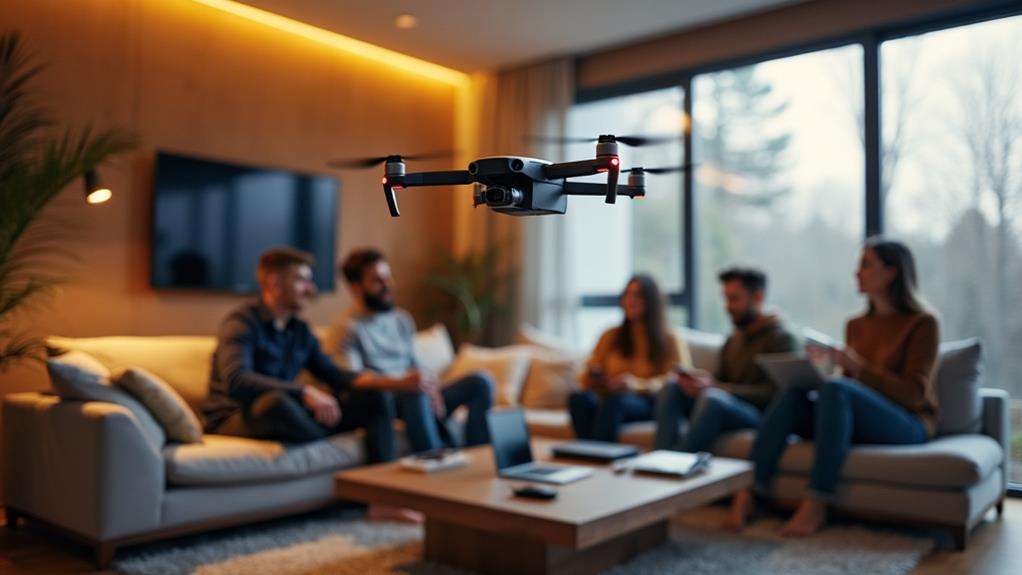
Community members express mixed feelings about flying drones indoors due to safety concerns and potential accidents. They emphasize the importance of using propeller guards and conducting thorough pre-flight preparations to mitigate common challenges. Experienced pilots suggest that indoor practice can build confidence, provided you are fully aware of your drone's capabilities and the environment.
Safety Concerns Indoors
Flying a drone inside a house presents unique safety challenges that must not be overlooked. One of the primary concerns is the abundance of obstacles such as walls, furniture, and people, which significantly increase the risk of accidents and crashes. Additionally, the absence of GPS stabilization indoors complicates drone control, necessitating greater reliance on manual flying skills and situational awareness.
Many users report that the lack of GPS can lead to discomfort and unease due to limited visibility and potential loss of control. Even if your drone is equipped with obstacle avoidance systems, these features may not function as effectively indoors, adding another layer of risk.
To mitigate these safety concerns, it's crucial to inform everyone in the room about the drone's presence and encourage them to maintain a safe distance. This helps prevent anyone from being caught off guard, thereby reducing the likelihood of accidents. By being aware of these indoor flying challenges and taking the necessary precautions, you can significantly enhance safety during your indoor drone operations.
Common Challenges Faced
Navigating the complexities of indoor drone flight presents several challenges that many enthusiasts encounter. The risk of crashes increases significantly in confined spaces filled with obstacles like walls, furniture, and ceilings, making maneuvering more difficult.
Without GPS stabilization, maintaining a consistent flight path relies solely on your piloting skills, which can be quite demanding in tight quarters. Magnetic interference from household electronics, such as microwaves and televisions, can disrupt your drone's signal and navigation, complicating control.
Obstacle avoidance systems that work well outdoors often falter indoors due to limited space, leading to more collisions. Additionally, internal drafts from air conditioning or heating systems can destabilize your drone's flight, causing unpredictable movements.
Flying indoors requires extra caution and skill to navigate these challenges effectively.
Shared Best Practices
Many drone enthusiasts recommend starting with smaller, lightweight drones when flying indoors to minimize potential damage. This is particularly important for beginners, as controlling a drone in a confined space can be challenging. Flying a drone indoors offers a controlled environment, helping you gain confidence without worrying about external factors like wind or wildlife.
Using propeller guards is crucial for indoor flying. They protect both your drone and your surroundings from accidental bumps and collisions. The drone community strongly emphasizes safety, suggesting that you always use these guards to minimize risks.
Before you start flying, clear the area of obstacles and ensure adequate lighting. This preparation enhances safety and improves your drone's performance. Additionally, maintaining situational awareness is essential—notify others in the area about your drone's presence to avoid accidents.
One of the benefits of indoor flying is that it is exempt from FAA regulations. This means you don't need to register or be certified, whether you're a licensed or recreational pilot. However, the drone community still advises following safety precautions to ensure a smooth experience. By adhering to these best practices, you'll enjoy a safer and more enjoyable indoor flying experience.
Key Features Comparison
Choosing the right indoor drone involves comparing key features that cater to your specific needs. The DJI Avata stands out with its compact 180x180 mm design and 4K camera, perfect for immersive indoor flights. This drone is built for tight spaces, ensuring stunning visuals without compromising maneuverability.
Next, consider the DJI Mini 3 Pro. Although primarily an outdoor drone, its advanced obstacle sensors make it a reliable choice for indoor use, enhancing safety during flights. Weighing only 249 grams, it is lightweight yet packed with technology to avoid mishaps.
For budget-conscious buyers, the DJI Mavic Mini 2 offers excellent value at $379. Suitable for both indoor and outdoor flights, it boasts a 31-minute flight time and a 4K camera, providing a balanced mix of affordability and performance.
The HoverAir x1 presents a unique option, operating without a traditional controller and featuring propeller guards for added safety. Priced at $439, its compact design supports easy navigation within confined spaces.
All these drones incorporate features like obstacle avoidance and customizable flight modes, ensuring a safe and enjoyable indoor flying experience.
Safety Tips Indoors
Ensuring safety while flying drones indoors is crucial to prevent accidents and damage. To make your indoor flying experience safe and enjoyable, follow these essential safety tips.
- Use Propeller Guards: Equip your drone with propeller guards to protect both the drone and its surroundings, reducing the risk of damage from accidental collisions.
- Check Lighting Conditions: Ensure adequate lighting in your indoor flying area. Good lighting enhances the performance of Vision Positioning Sensors, providing better stability and control.
- Conduct Pre-flight Checks: Perform thorough pre-flight checks. Assess potential magnetic interference and ensure a clear flight path to avoid unexpected obstacles.
- Choose the Right Drone: Select drones designed for indoor use. The DJI Avata, with its compact size and high-quality 4K camera, is ideal for maneuvering in tight spaces. For beginners, the HoverAir x1 offers pre-programmed flight paths and operates without a controller, making it a user-friendly option.
Key Features of Popular Models
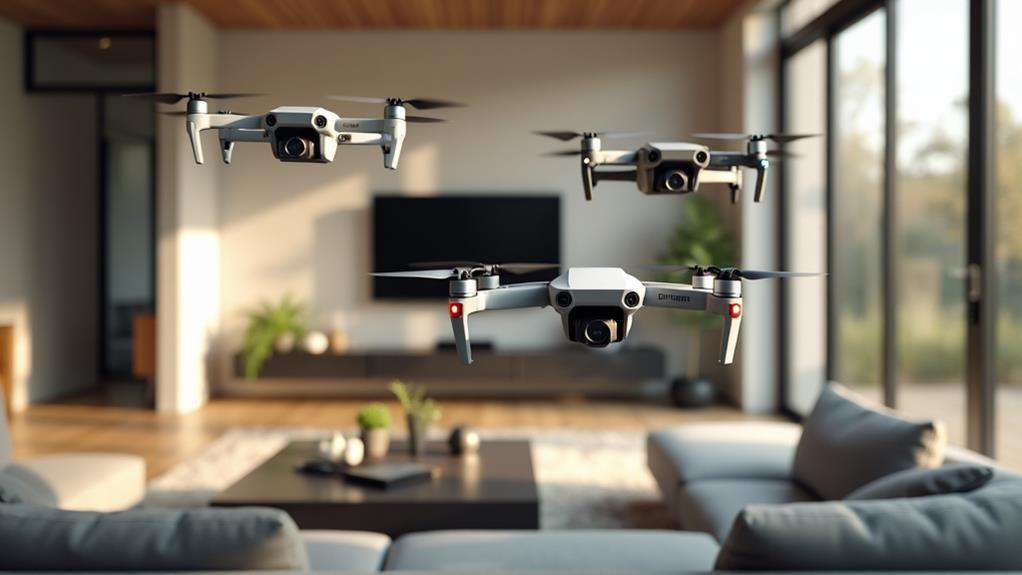
When exploring key features of popular indoor drone models, it's crucial to identify what sets each one apart. The DJI Avata excels in tight indoor spaces with its compact 180x180 mm size and a high-quality camera capable of shooting 4K at 60fps. Its advanced stabilization technologies ensure smooth video capture, even in confined areas, making it highly reliable.
The DJI Mini 3 Pro, weighing just 249 grams, enhances safety with forward, backward, and downward visual sensors, reducing crash risks during indoor flights. Its lightweight design aids maneuverability, facilitating easy indoor navigation.
For those prioritizing simplicity, the HoverAir x1 operates without a controller and includes pre-programmed flight paths, making it extremely user-friendly. Its propeller guards provide added safety, ideal for indoor use.
Indoor Flying Tips
To make your indoor drone flying experience as smooth and safe as possible, follow these essential tips:
- Attach Propeller Guards: Always attach propeller guards to your drone. They help protect both the drone and surrounding objects from potential collisions, reducing the risk of damage.
- Clear the Flight Space: Ensure your flight space is free of large obstacles and clutter. This minimizes the risk of accidents and provides ample room for maneuvering.
- Ensure Adequate Lighting: Make sure the indoor area is well-lit. Adequate lighting enhances the drone's positioning sensors, improving stability and control, which is crucial for smooth indoor flights.
- Practice and Adjust Settings: Familiarize yourself with the environment by practicing maneuvers before actual flights. Adjust the drone settings, such as switching to CineSmooth mode for slower, more controlled movements, and using hover mode to maintain stability in case of signal loss indoors.
Audience Engagement Techniques

How can you captivate your audience during indoor drone flights? Start by creating an engaging atmosphere that sparks curiosity about drone flying. Demonstrate unique flight maneuvers and capture compelling aerial perspectives to instantly grab your audience's attention, showcasing the exciting potential of drones.
Share personal experiences and insights from the drone community to bridge the gap between novice and experienced pilots. This encourages interaction and discussion, making the experience more relatable and fostering a deeper connection with your audience.
Utilize storytelling techniques to highlight your drone's capabilities. Weave narratives into your presentation to make the information more memorable and engaging. For example, describe a scenario where your indoor drone flying skills were particularly useful or solved a problem.
Highlight safety measures and responsible flying practices. Emphasizing safety not only informs your audience but also builds trust, demonstrating your commitment to community standards and ensuring everyone enjoys the experience safely.


